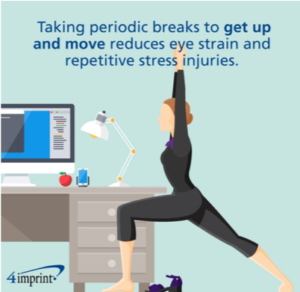Author: Angela Mucci —
Workplace Wellness Programs are increasingly popular and are often designed to be easily accessible and convenient, but that wasn’t always the case. According to Corporate Wellness Magazine, when co-workers started horseback riding together outside their offices in the 1800’s it was an activity only available for the highest level employees. In the 1900’s companies like Hershey Foods built entire recreation complexes for employees, which often included a swimming pool and basketball court. In the 1970’s worksites started to focus on more practical-sounding things like chronic disease prevention, routine preventative screenings and smoking cessation.

Source: http://clipart-library.com/clipart/726499.htm
Current worksite wellness programs may not be as fancy as those from days of old, but they are still effective, and, due to necessity-being-the-mother-of-invention, the lower-budget programs of today inspire organizers to come up with fun, innovative and creative ways to get people involved. Some of the first fitness-at-work programs required saddles, boots, and perhaps thousands of dollars worth of equipment. What are some of the more recent tools popular amongst workplace wellness programs?
Nan Kramer, Worksite Wellness Coordinator for MountainWise said: “Generally when I work with a site to help them reach their goals MountainWise provides them with some basic essentials: a medicine ball, yoga mats, dumbbells for weight lifting, a poster with stretches or other exercises, a blender for smoothies, and sometimes a treadmill or an elliptical machine. Fitbits are not necessary but they do help people track their progress and can make useful prizes for at-work competitions.”
MountainWise Meets Champion Credit Union
In August of 2018 Nan presented at a Haywood County Human Resource (H.R.) association meeting, where the Champion Credit Union(C.C.U.) H.R. department happened to be looking for ideas after Credit Union CEO Jake Robinson said he wanted to bring a wellness program to the bank. H.R. Specialist Melanie Mooney said that “the stars just aligned because there was Nan talking about workplace wellness programs!”
Nan, Melanie and H.R. Director Debbie Hall collaborated to launch a Wellness Program at local C.C.U. branches, starting with the use of questionnaires to see who wanted to be involved and what kinds of activities employees were interested in. The response was encouraging. Workers from every local branch of C.C.U. volunteered to be on the “C.C.U. Wellness Committee” in order to bring the program to their local office.
Motivation: Money Talks, People Walk.
Motivation, or lack-thereof, is one of the biggest challenges when it comes to getting people to make life changes or to participate in wellness programs at work. Alma Lopez, wellness coordinator at the Arden C.C.U. site, stepped up after nobody else did. “Nobody was motivated at the beginning and I figured that the best way to stay motivated myself was to sign up as an organizer”, says Alma. She soon discovered that small cash prizes and competitions got people involved at the beginning. “We set up a jar, and everyone who wanted to participate put five dollars in the jar. Then whoever walked the most miles at the end of the year won all the money in the jar.” Once the ball was rolling more and more people started to get involved. “When people saw their co-workers doing things, they decided to join.”
According to Nan: “Healthy competition can get people motivated and excited to participate. You hope for intrinsic motivation from participants but people like to win bragging rights or a prize. Having challenges between teams or departments also helps to build camaraderie between co-workers while they have fun and support each other.” The challenges are meant to be light-hearted and serve to raise awareness and increase focus. Prizes often spark initial motivation, which usually continues when people start to feel better. Nan reports success with the following challenges and themes:
– Walk 10,000 Steps a Day.
– Couch to 5K.
– Bring a Healthy Lunch (for an allotted time frame).
– Eat a Healthy Breakfast (for an allotted time frame).
– Get Enough Sleep.
– Drink Enough Water.
– Weight Loss Challenge. (flexible, individualized amount)
– 10 Days of No Sugar.
– Coast to Coast (an online cycling competition across the US)
Raygan Nunez from the C.C.U. branch in Canton incorporates use of a third party program to facilitate challenges. “We do an online coast to coast challenge, where people compete with workers all the way across the country and earn points for exercising and other challenges.” People at her site can also earn points and earn a paid day off next year.
Like Alma, Raygan reports that the power of example is a strong motivator. “I have seen people that you would not expect to get involved start to get active at work after seeing that their co-workers are having fun or have more energy; sometimes people will walk on the treadmill for ten minutes during lunch, others use standing desks and I have been hearing talk about healthy recipes and people are trying new foods.” The wellness coordinators meet or talk by phone every month to exchange ideas, which motivate them all to try new things.
Mental Health Investments Bring Worthwhile Returns
More and more businesses are seeing the link between mental health and work performance. One study for example, reported that “about 40 percent of the workforce’s sickness absence was due to stress, depression, or anxiety – an average of 23 days per affected person in 2013-2014.”

Source: https://info.4imprint.com/blog/promote-workplace-wellness-fitness-swag/
With this awareness, the C.C.U. wellness committee knew that it was important to bring a holistic approach to the table, with a goal to “emphasize nutrition and mental wellness. We want it to be well-rounded and also want to stress baby steps.” She added that “employees can get stressed from dealing with other people’s money. We want to make sure they have mental health help if they need it.” The committee offered a massage gift certificate as a prize and every branch reminds employees that mental health help is available and helps them locate resources. They plan to incorporate mental health care into future programs, an increasingly popular approach due to the fact that the returns are worth the investment. According to a study presented at a global health conference: “the returns on this [mental health care] investment in a country can be substantial as measured by a favorable benefit-to-cost ratio, ranging between 2.3-3.0 to 1 when economic benefits only are considered.” In other words, mental health care is good for the individual and the company.
Champion Credit Union brought workplace wellness to their Western North Carolina branches one year ago and the programs are thriving in Waynesville, Arden, Asheville, Mills River and Canton. The Champion Credit Union wellness committee continues to work with the branches at each location and also coordinates with other community centers like the YMCA and local gyms in order to offer discounts for employees and to inspire motivation. They also coordinate with medical centers in order to bring biometric screening. While some workplace fitness programs started with grand gymnasiums and exclusive, expensive activities, this humble community approach, combined with the creativity generated at each C.C.U. has been a recipe for success.
During the past five years MountainWise has collaborated with 40+ worksites to bring wellness programs to Western North Carolina. To bring a workplace wellness program to your place of business, contact Nan Kramer at (704)562-2828 or nan@mountainwise.org.
Sources
